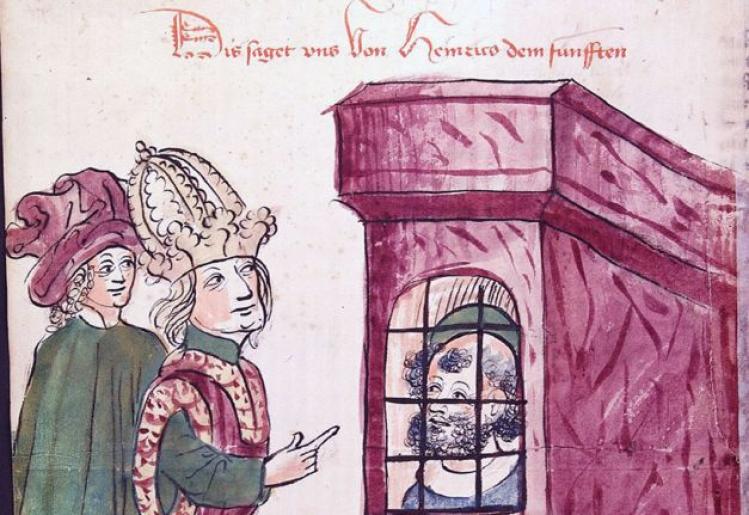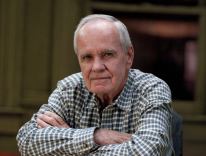
Published in 2010, 2012, and 2015, the three volumes of The Emergence of Western Political Thought in the Latin Middle Ages constitute the culmination of a lifetime’s thinking about Western political thought. Francis Oakley’s ideas are controversial in the best sense: they stir up lots of discussion.
Right off the bat, his overall title will strike most observers as preposterous. The emergence of Western political thought...in the Middle Ages? Everyone knows that our political philosophy derives from democratic Athens and republican Rome, followed by the Renaissance retrieval of those two traditions and finally the secularization launched by the Enlightenment. The Middle Ages were about popes and emperors, Christendom, lords and vassals: priestcraft, in other words, not statecraft. In this conventional view, proper political thought could not develop until the millennium-long religious eczema that was the Middle Ages was cured by modernity.
But the historian Frank Oakley, president emeritus of Williams College, has an instinct for excavating deep beneath conventional wisdom. While the traditional progression of Western political thought is held to be secular-religious-secular, he argues that it is in fact religious-religious-secular. He rejects the idea that Greece and Rome were secular, or that Christianity made purely political thought impossible. And he insists that the “seedbed” for consent and individual rights, which are central to modern political thought, lies in the Latin Middle Ages. That’s the brochure for the journey Oakley takes his readers on. Let’s visit some sites along the trip.
Volume 1: Empty Bottles of Gentilism: Kingship and the Divine in Late Antiquity and the Early Middle Ages (to 1050), (Yale University Press, $50, 306 pp.), addresses kingship, “the political commonsense of humankind.” Oakley shows how cosmic kingship, which arose in ancient Mesopotamia, represented a fusion of religion and politics in which kings were held to be divine, semi-divine, or else instituted by divinity. Hellenistic writers added a philosophical gloss to their inheritance and passed along the result to the Romans and their emperor cult. Jewish and Christian traditions ought to have excluded such rulership: Hebrews drew a sharp distinction between creator and creation, one that stripped rulers of sacrality and thus “disenchanted” the world, in Schiller’s phrase, while Jesus shifted emphasis from a covenantal view of the relationship between a people and God to a personal relationship between individual souls and God. This shift demanded a “dramatic...limitation on the allegiance that human beings owed to any earthly society.” And so in a Christian dispensation royal religion ought to have vanished. Yet several forces kept it visible and brought it into ever keener focus. St. Paul said that all power comes from God, and St. Luke saw a convergence between the Roman and the Christian stories. The Greek fathers, especially Eusebius, effected an accommodation between sacral kingship, Christianity, and the Roman Empire. Eusebius’s “beguiling evocation of the parallelism between divine and human regality,” writes Oakley, “was destined for an extraordinarily long life.”
Augustine did not share the “providentialist enthusiasm” of most other Church Fathers; for him no earthly institution, whether empire or church, was sacred or could serve as a tool of God’s plan for salvation. But his was a lonely voice. Ironically, in the early Middle Ages, Augustine’s City of God was understood in a Eusebian sense. The Carolingians combined ancient Germanic ideas of sacrality with biblical, patristic, and liturgical ideas to equate their church and empire and to see the resulting imperium Christianum as the earthly manifestation of the divine will. “Political Augustinism” was the term long applied to this kind of polity. Carolingian kingship had a priestly aura, and by the middle of the eleventh century this kingship had become Christocentric. Yet concepts and practices of reciprocal fidelity and consent, connected with what historians still call “feudalism,” limited its aspirations to absolutism.
Volume 2: The Mortgage of the Past: Reshaping the Ancient Political Inheritance (1050–1300), (Yale University Press, $60, 327 pp.), deals with kingship in the high Middle Ages, and reveals how three encounters with the past influenced it. First, the naturalistic philosophy of Aristotle was gradually domesticated; Aristotle’s view of man as a political animal whose true ends could only be met in a political community rebutted both Augustine’s view that government was a punishment for sin, and the opposite view that government was a central element of God’s plan for human salvation. Second, the recovery of Roman law and the veritable explosion of canon law generated a great deal of rumination on absolute rule in both church and empire, directing greater attention to the papacy. Third, reflection on the early church uncovered a spiritual tradition that emphasized intention and consent.
The Gregorian Revolution—the massive program to reform church and society associated with Pope Gregory VII—tried to strip kings of sacrality, insisting that they were merely laymen. Even their temporal jurisdiction within their kingdoms was up for discussion. Did they rule on their own, or by delegation from the ecclesiastical hierarchy? As thinkers diminished royal sacrality, they also argued that the king had to rule justly, seeking the common good and not merely his own. An unjust king was a tyrant, and his people had a right to resist him. Still, medieval writers had little to say about who the “people” were or how they were to voice their resistance to tyranny.
As an institution, the papacy grew in unprecedented ways after the Gregorian epoch, and reflections on the papal office grew apace, as thinkers tackled themes of power and authority. The former dealt mainly with the effective exercise of rule and the capacity to coerce. The latter dealt with legitimacy. Commentators on canon law spoke of “the fullness of power” possessed by the pope, a concept that owed not a little to Roman dicta such as “What pleases the prince has the force of law” or “The law is in the mouth of the prince.” But did the pope’s jurisdiction include both the ecclesiastical and the temporal realms, or just the former? High papalists, whose views were preponderant in the high Middle Ages, viewed the pope as all-powerful within a hierarchically structured universal Christian commonwealth. Fainter voices would have excluded the pope from the temporal realm.
One could argue that both continuity and change are apparent in concepts and practices of rulership in the high Middle Ages. What’s clear is that something new had arrived on the scene—namely, representative institutions, which appeared everywhere, and in many different forms, in the twelfth and thirteenth centuries. A unique contribution of the medieval centuries, they too owe something to Roman ideas, especially the principle that “What touches all by all must be approved.” Representative institutions also gathered up and articulated consent. It is worth noting that this consent was not political or democratic in any modern sense, but rather procedural and consultative. Moreover people (almost always men, to be sure) expressed themselves as members of groups—clergy, knights, burghers, barons, members of guilds or cathedral chapters, among others—and not as autonomous individuals. Nevertheless, a big step had been taken.
As Oakley tells the story, in 1122 Emperor Henry V of Germany and Pope Calixtus II concluded the Concordat of Worms, which put an end to the Investiture Controversy, the decades-long battle over whether kings or emperors, as laymen, had the right to invest members of the clergy with the ring and staff of office. Worms left three problems in suspense. First, the secularization of rulership had not been settled. Kings did not meekly agree that they were mere laymen, and the popular view of them as hallowed figures lived on in such rituals as the “Royal Touch,” the belief that the king could, by his touch, heal certain diseases. Second, the relationship between pope and bishops remained unclear—as it has until today. And finally, the governance of the church and the role of the cardinals was left murky.
THESE PROBLEMS FORM the backdrop for Oakley’s third and final volume, Volume 3: The Watershed of Modern Politics: Law, Virtue, Kingship, and Consent (1300-1650), (Yale University Press, $85, 415 pp.), the core of which is devoted to conciliarism and the right of resistance. In both idea and practice, conciliarism had deep roots in the Middle Ages, but it was specifically provoked by the Great Western Schism (1378–1417) and by the classic age of councils: Pisa 1409, Constance 1414–1418, and Basel 1431–1449. Resistance too owed something to medieval precedent, and something to new and unforeseen developments, especially the Reformation. Both, moreover, are built upon high-medieval concepts of consent.
Before the papacy plunged into the crisis of schism and council, it was the subject of both effusive elevation and angry criticism. High papalists, including such unfamiliar figures as Augustinus Triumphus and Alvarus Pelagius, argued for a unitary Christian society, aligned with the church. In it, the emperor derives his authority from the pope. Papal power is direct from God; the church is a hierarchical clerical corporation, and within it the potestas ordinis (the power that attaches to the priestly office) and the potestas jurisdictionis (the power to govern) are one. One is hard pressed to say whether this is a political or an ecclesiological theory.
The papacy had its critics. Dante in his Monarchia sought to restrict the pope to the spiritual sphere. Marsiglio of Padua extolled the same view at greater length and with white-hot intensity. The chief cause of all Europe’s troubles, he wrote, was the temporal authority of the pope. Priests, he said, succeeded only to Christ’s human nature, and had no right to compel. In any community the “human legislator” makes the law to which the people in a given place are bound, and the pope has no right to intrude. William of Ockham sought, as it were, to desacralize temporal power and desecularize ecclesiastical power, arguing that since Christ had no temporal kingdom, neither could the apostles or their successors. John Wycliffe likewise denied the pope any authority in the temporal realm—and went further than the others, denying the pope meaningful authority even within the church.
But the most powerful check on papal power, as Oakley relates, came from conciliarism, a set of ideas with deep antecedents in both the patristic and Carolingian periods. Conciliarism could mean anything from church reform effected through councils, to a vision of the church as a kind of mixed monarchy, with pope, cardinals, and councils sharing power in various combinations. Strictly speaking, however, conciliarism was an ecclesiology assigning the pope to the role of a constitutional ruler subject to correction by the faithful, exercising their authority via councils (see Oakley’s “Authoritative & Ignored,” October 24, 2014). The papacy loathed conciliarist ideas and concluded a series of concordats with secular rulers that effectively renounced the idea of a universal Christian order and divided the church into a series of national communities. Through such arrangements the popes managed to persuade secular rulers that conciliarism harbored real threats to their own power.
Into this maelstrom came the Protestant reformers. Luther obliterated the difference between clergy and laity, eliminated the clerical hierarchy, and announced that clergy existed only to preach the Gospel and rebuke sin. Secular rulers were to be obeyed without question unless they interfered in the spiritual sphere. God rules through them, Luther averred, and temporal rule was a remedy for sin. The Reformed tradition went further than Luther did in equating the temporal and spiritual spheres while disagreeing on where authority resided: for Zurich it lay with temporal rulers, for Geneva with the religious.
OUT OF THIS extraordinarily complex situation, Oakley explains, at least three outcomes can be perceived. First, both popes and kings once again asserted the religious roots of their authority in the face of consent-based challenges. Where the popes were concerned, high papalists like Robert Bellarmine stressed the divine and absolute nature of papal authority; and medieval theocratic kingship, meanwhile, was augmented in what has come to be called the “divine right of kings,” with monarchs answerable only to God, subjects bound to obedience on pain of hell, and hereditary succession kept exempt from forfeiture.
Next, the right of resistance took shape, as the fear that the state might seek to crush religious communities, along with the increasing awareness that those communities differed sharply among themselves, spurred theories of legitimate opposition to tyranny. In part, such theories derived from the idea that Scripture or conscience conferred a right to resist a ruler who would command what is wrong. But even Protestant writers plundered conciliarist writings for concepts and expressions that legitimated opposition. Conciliarist writings were a crucial conduit for medieval constitutionalist thinking. One of Oakley’s key findings is the way in which political and ecclesiological ideas meshed with each other. Such syntheses—and resulting paradoxes—found their apotheosis in the case of Charles I of England, whose healing “royal touch” was felt by more than thirty thousand people—and whose head was chopped off by parliamentarians who believed they had a right, perhaps a duty, to resist him.
Finally, while consent in the religious sphere suffered diminution, in the temporal sphere it flourished as never before. Gradually there arose the conviction that the legitimation of political authority required the “free consent of a concatenation of individual wills”—and that such freedom, to be meaningful, included the right of consent to be withheld as well as granted. This doctrine was called into being by medieval juristic, political, and ecclesiastical life, shaped by Romano-canonical corporate thinking, and connected with a natural-law tradition that was Hellenistic, philosophical, and universal. The resulting synthesis was impregnated by Christian notions of moral autonomy, individualism, and voluntarism that were biblical and patristic. In the end, however, the seventeenth century did not witness a concept of subjective rights attaching to autonomous individuals and did not create durable institutional forms for the expression of either consent or resistance.
If it looked as though royal religion remained robust in the seventeenth century, its temporal brand had little future. (Its papal brand is another story.) Royal religion was not the heart of medieval political thought, however, but its rival. As Oakley makes clear in this meticulously documented and cogently argued book, constitutionalism, consent, and resistance are the chief modern inheritances from our medieval past.
Please email comments to [email protected] and join the conversation on our Facebook page.
Share
Previous Story
Reactance: Yet Another Explanation!
Next Story
Letters | Episcopal ineptitude, the Falkland War, Soccer


